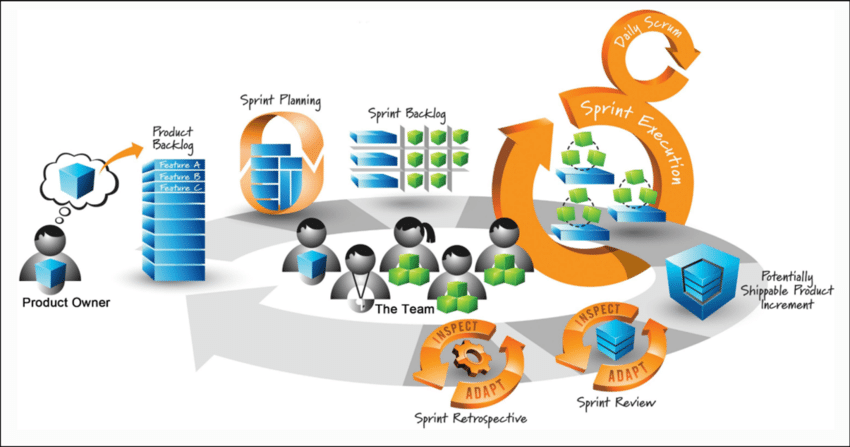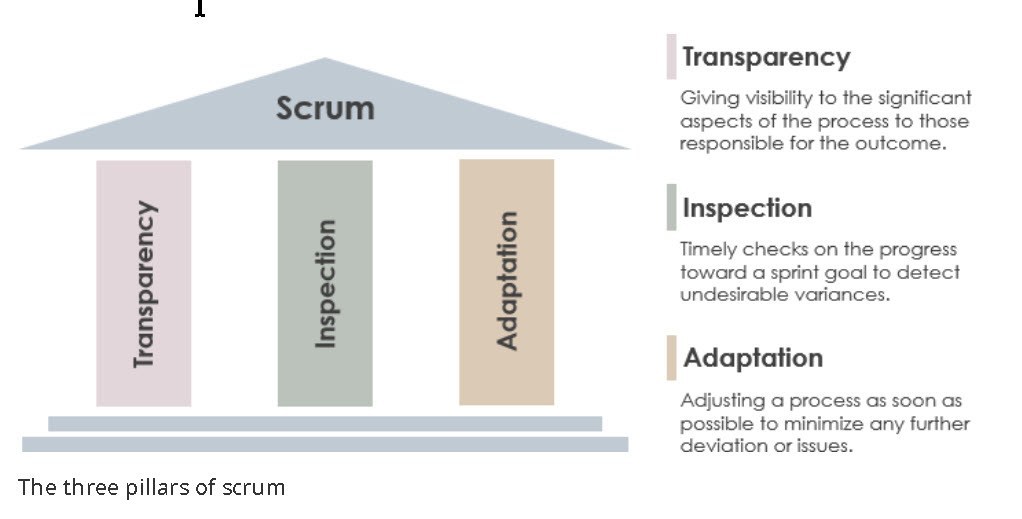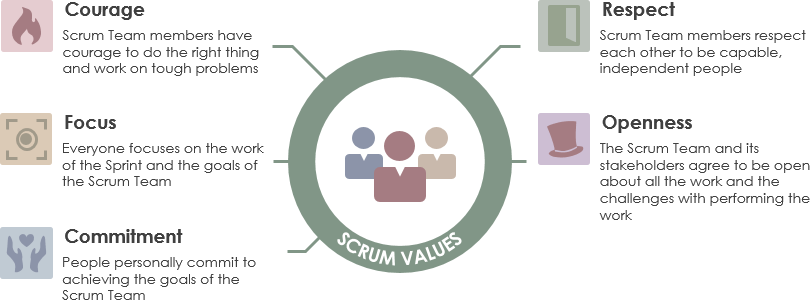Scrum Theory is a part of Agile methodology. Agile is a time-boxed, iterative approach to software delivery that builds software incrementally from the start of the project, instead of trying to deliver it all at once near the end. It works by breaking projects down into little bits of user functionality called user stories, prioritizing them, and then continuously delivering them in short Two to Four weeks cycles called Iterations or Sprints. Requirements and solutions evolve through collaboration between Self-Managing & Cross-Functional teams.
Agile principles and values foster the mindset and skills businesses need in order to succeed in an uncertain and turbulent environment. The agile Principle states the best architectures, requirements, and designs emerge from self-managing teams. Scrum Theory builds on the 4 Agile values and 12 principles.
Question: What is the difference between Methodology and Framework?
Answer: Methodology is much more complete and will specify how work should be done whereas a framework, on the other hand, is purposely incomplete ( like SCRUM, XP, Crystal). For example in Scrum Framework how product backlog comes into existence or how the team will deliver sustainably pace to deliver value is not specified, it is purposefully left incomplete so that team will decide the best course of action to achieve it.
Question: What is Agile?
Agile is a time boxed, iterative approach to software delivery that builds software incrementally from the start of the project, instead of trying to deliver it all at once near the end. It works by breaking projects down into little bits of user functionality called user stories, prioritizing them, and then continuously delivering them in short two week cycles called iterations.
- User stories: User stories are features our customers might one day like to see in their software.They are written on index cards to encourage face-to-face communication. Typically no more than a couple days work, they form the basis of our Agile plans.We get them by sitting down with our customers and asking lots of questions.
- Iteration: It is a short one to four weeks period where a team takes their customers most important user stories and builds them completely as running-tested-software.
Agile Manifesto
The Agile Manifesto is a brief document built on 4 values and 12 principles for agile software development.
Agile Values
The Agile Manifesto also outlines 4 values for agile development practices. Here the key is the word “OVER” i.e. Agile is not suggesting completely eliminating the right-hand side of the statements rather it is suggesting prioritizing the left-hand side of the statement over the right-hand side.
- Individuals and interactions over processes and tools: Developers drive the development process and respond to business needs on the fly, so they take precedence over processes and tools. If the processes and tools drive development then the team becomes less responsive to customer needs. Interactions among individuals also help in reducing conflicts among Agile teams.
- Working software over comprehensive documentation: Good face-to-face communication supplemented by lean but sufficient documentation. The team should determine what level of documentation is appropriate and produce just enough documentation. By avoiding non-important documentation, Agile shifts the team’s focus from the process itself to the results of the process i.e. working software.
- Customer collaboration over contract negotiation: Focus on what we are trying to build with our vendors, rather than debating the details of contract terms. Scrum Teams deliver products iteratively and incrementally, maximizing opportunities for feedback. So to maximize the value of the delivered product regular and frequent feedback from the customer through collaboration is essential. Here customer becomes important collaborator throughout the development process, ensuring their input is incorporated, and the result meets their needs along the way.
- Responding to change over following a plan: Changes are accepted at any time during the development effort depending on the business value of the change, the Product Owner’s acceptance, and the ability of the team to respond in a timeframe acceptable to the Product. Agile embraces change, focusing on releasing a minimum viable product that can be evaluated and adjusted from iteration to iteration.
Agile Principles
The Agile Manifesto also outlines 12 principles for agile development practices.
- Our highest priority is to satisfy the customer through the early and continuous delivery of valuable software.
- Welcome changing requirements, even late in development. Agile processes harness change for the customer’s competitive advantage.
- Deliver working software frequently, from a couple of weeks to a couple of months, with a preference for the shorter timescale.
- Business people and developers must work together daily throughout the project.
- Build projects around motivated individuals. Give them the environment and support they need, and trust them to get the job done.
- The most efficient and effective method of conveying information to and within a development team is face-to-face conversation.
- Working software is the primary measure of progress.
- Agile processes promote sustainable development. The sponsors, developers, and users should be able to maintain a constant pace indefinitely.
- Continuous attention to technical excellence and good design enhances agility.
- Simplicity–the art of maximizing the amount of work not done–is essential.
- The best architectures, requirements, and designs emerge from self-organizing teams.
- At regular intervals, the team reflects on how to become more effective, then tunes and adjusts its behavior accordingly.
Agile is a mindset that is all about Transparency, Inspection, and Adaptation. For example, Scrum is one of the widely used frameworks under the Agile umbrella, which may help you in becoming more Agile, there are however many more frameworks within the Agile movement, like Kanban, XP, Crystal, and many more. The all-in approach is advantageous for organizations transitioning to Scrum as going all-in can reduce resistance, avoids problems created by having agile and traditional teams work together & transition will be over more quickly.
Scrum Theory
Scrum is an iterative incremental framework within which people can address (develop, deliver, and sustain) complex adaptive products. In other words, it helps people, teams, and organizations generate value through adaptive solutions for complex problems. At the same time, they can deliver products of the highest possible value in a productive and creative manner. Scrum is not a process, technique, or definitive method. Agile software development with Scrum is often perceived as a methodology; but rather than viewing Scrum as methodology, think of it as a framework for managing a process with short cycles.
A few benefits of short cycles are
- Fast feedback.
- Continuous improvement.
- Rapid adaptation to change.
- Accelerated delivery.
Scrum helps businesses:
- Innovate faster.
- Move from idea to delivery more quickly.
- Drive higher customer satisfaction.
- Increase employee morale.
Question: What are the differences Between Scrum & Agile?
The difference between agile and Scrum is that agile refers to a set of principles and values shared by several methodologies, processes, and practices; Scrum is one of several agile frameworks–and is the most popular.
Scrum Framework
Scrum is a process framework that allows addressing complex problems to deliver products of the highest possible value. It is not a process, technique, or definitive method. Rather, it is a framework within which you can employ various processes and techniques. Scrum makes clear the relative efficacy of current management, environment, and work techniques so that improvements can be made.
The Scrum framework consists of the Scrum teams with associated Scrum Roles, Scrum Ceremonies, Scrum Artifacts, and Scrum rules. Scrum organizes projects using cross-functional Scrum Teams, each one of which has all of the capabilities necessary to deliver a piece of functionality from idea to delivery.

Characteristics of Scrum
Scrum is:
- Lightweight framework: Scrum is a lightweight framework. It comprises of the rules and practices that are few in number and easy to follow.
- Simplicity: One unique identity of Scrum is that it is simple to understand. This makes the framework easy to comprehend even for beginners.
- Difficult to master: There is a big difference between understanding Scrum and implementing it in real-time projects. It is therefore somewhat difficult to master Scrum. You need to practice in real-time and learn the concepts in-depth. While working with Scrum, one should properly understand why each component is in place, how it delivers value as a discrete element, and also in relation to the other elements.
Question: What are the Application Areas of Scrum?
Scrum was originally developed to organize and develop products.Scrum is now broadly used for all the services, products, and in managing the organizations.
- Research and identify viable markets, technologies, and product capabilities;
- Develop products and enhancements;
- Release products and enhancements, as frequently as many times per day;
- Develop and sustain Cloud (online, secure, on-demand) and other operational environments for product use; and,
- Sustain and renew products.
Scrum Theory – Empiricism
Scrum is based on the theory of Empirical process control, which relies on Transparency, Inspection, & Adaptation. Empiricism asserts that knowledge comes from experience and making decisions based on what is observed. Scrum is also based on Lean thinking. Lean thinking reduces waste and focuses on the essentials.
Empiricism means working in a fact-based, experience-based, and evidence-based manner. Scrum implements an empirical process where progress is based on observations of reality, not fictitious plans. Scrum also places great emphasis on mindset and cultural shift to achieve business and organizational Agility.
Iterative: A process for arriving at a decision or a desired result by repeating rounds of analysis or a cycle of operations. The objective is to bring the desired decision or result closer to discovery with each repetition (iteration).
Incremental: A series of small improvements to an existing product or product line that usually helps maintain or improve its competitive position over time. Incremental innovation is regularly used within the high technology business by companies that need to continue to improve their products to include new features increasingly desired by consumers. The way Scrum teams deliver pieces of functionality into small batches is incremental.
Three Pillars of Empirical Process Control / Scrum Theory

Transparency: To make decisions, people need visibility into the emergent process, work, and the current state of the product. To ensure everyone understands what they are seeing, participants in an empirical process must share one language & artifacts must be highly transparent. Artifacts that have low transparency can lead to decisions that diminish the value and increase risk.
Scrum Reviews Provide Transparency. Scrum’s frequent reviews give team members and stakeholders a clear view of the state of the project. Transparency enables inspection. Inspection without transparency is misleading and wasteful.
Inspection: To prevent deviation from the desired process or end product, people need to inspect what is being created, and how, at regular intervals. Inspection should occur at the point of work but should not get in the way of that work. To help with inspection, Scrum provides cadence in the form of its five events. An inspection enables adaptation.
Adaptation: When deviations occur, the process or product should be adjusted as soon as possible. The adjustment must be made as soon as possible to minimize further deviation. A Scrum Team is expected to adapt the moment it learns anything new through inspection.
Scrum prescribes five formal events for inspection and adaptation, as described in the Scrum Events section of this document:
- The Sprint
- Sprint Planning
- Daily Scrum
- Sprint Review
- Sprint Retrospective
Scrum Theory – Scrum Values
A team’s success with Scrum depends on five values: Commitment, Courage, Focus, Openness, and Respect. These values build trust in the scrum team & the presence of trust is positively correlated with team performance & motivation.

Commitment: People personally commit to achieving the goals of the Scrum Team. Scrum masters reinforce a team’s commitment when they facilitate sprint planning, protect teams from mid-sprint changes, and deflect excessive pressure from product owners.
Courage: Scrum Team members have the courage to do the right thing and work on tough problems. Great Scrum masters help foster team courage by creating safety for team members to have difficult conversations with one another, with the product owner, and with stakeholders. Scrummasters are fearless about removing impediments that slow the team’s progress. Scrummasters also stand up to stakeholders to prevent changes or side projects during the sprint while also helping teams adapt when priorities shift between sprints.
Focus: Everyone focuses on the work of the Sprint and the goals of the Scrum Team. Scrum masters encourage team focus by holding the team to their own definition of done, encouraging full team participation at each daily scrum, and by ensuring that team members only present work that is complete at the sprint review.
Openness: The Scrum Team and its stakeholders agree to be open about all the work and the challenges with performing the work. Scrum masters facilitate openness in daily scrums so the team is always aware of exactly how the sprint is going. Scrum masters encourage openness in sprint reviews by ensuring that stakeholder feedback is constructive and that team members are able to hear it. Scrum masters remind teams that learning about product shortcomings early is much less expensive and much more helpful than hearing about them late in the project, or worse after the product is in the customer’s hands. In the same way, Scrum masters foster an open environment in sprint retrospectives so that teams can grow and develop from sprint to sprint.
Respect: Scrum Team members respect each other to be capable, independent people. Scrum masters develop respect in their teams. They help teams listen to each other during daily scrums. They encourage teams to share their struggles and their successes. Scrum masters also point out times of strong collaboration and facilitate conversations around new ideas.
Table of Contents
- Scrum Framework – Scrum Theory
- Scrum Framework – Scrum Roles
- Scrum Framework – Scrum Events
- Scrum Framework – Scrum Artifacts
- Scaling Scrum – DoD – DoR – Scrum Framework
- Developing People and Teams
- Managing Products with Agility
- Developing and Delivering Products Professionally
- Evolving the Agile Organization – Scaled Scrum, Portfolio Planning & EBM
Scrum Guide: Click Here
